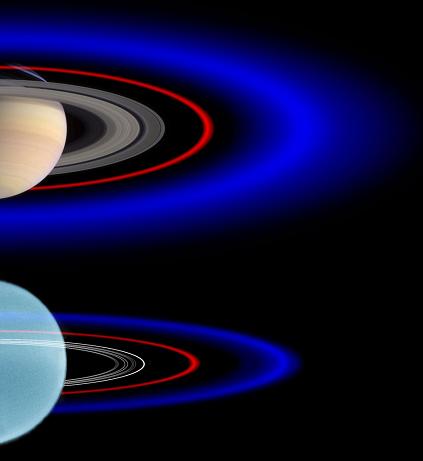American astronomers published this week in the journal Science, that the planet Uranus has a blue ring - only the second found in the solar system. Like Saturn's blue ring, its existence is due to a small companion moon
Blue rings for Saturn (above) and Uranus (below)
American astronomers published this week in the journal Science, that the planet Uranus has a blue ring - only the second found in the solar system. Like Saturn's blue ring, its existence is due to a small companion moon.
The scientists suspect that subtle forces act on the dust in the rings, allowing smaller particles to exist while the larger particles are captured by the moon. Smaller particles reflect blue light, a property that gives the ring its unique color.
All the other rings - those surrounding Jupiter, Saturn, Uranus and Neptune - are made of small and large particles, and therefore they appear reddish.
Astronomers have long known that Uranus is surrounded by rings of dark particulate matter containing particles up to 10 meters in diameter. However, last December two new rings for Uranus were discovered - the 12th and 13th by the Hubble Space Telescope and by observation in the infrared field from the Keck Telescope in Hawaii.
The outer ring and its accompanying icy moon, Maav, are not observable in the infrared, unlike the inner ring of the two new ones. A team led by Imke de Pether, a professor of astronomy at the University of California, Berkeley, discovered that the color of this ring is light blue, a rare color in planetary terms.
"The blue color means that this ring contains mainly sub-micron material - much smaller than the material in most of the other rings, which appears red" said Prof. de Pater. The tiny particles, which are about one-thousandth the width of a human hair, are scattered and reflect mainly the blue light, like the tiny molecules in the air that make the earth's sky blue.
The more common red rings also contain larger particles, which give the reflected light its color, up to a red color - caused by the presence of iron. The outer rings of Saturn and Uranus appear to be quite similar, not least because they are both associated with small moons.
moon danceThe moons circle the planet within the rings, Prof. Peter said. "They are affected by extremely tiny particles (micro meteorites). On a moon that has no atmosphere at all, these particles hit at high speed and throw matter into space. Because these moons are so tiny, these materials escape the moon's gravity and orbit the planet itself. The smaller particles remain in orbit while the larger particles fall back to the moon.
The scientists involved in the study plan to make more observations next year, when the paler moons of Uranus will be more visible to the eye.

